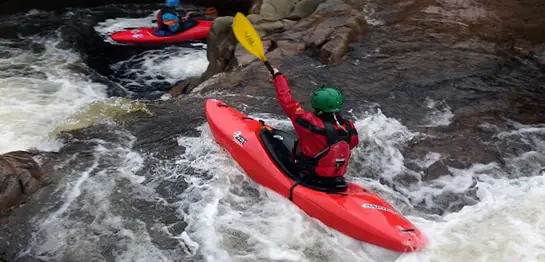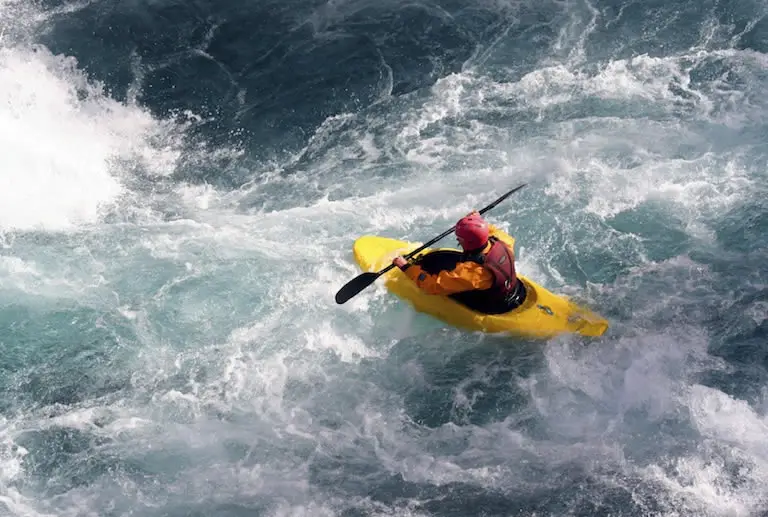Contents
Whitewater Kayaks Types & Uses
Whitewater kayaks are different from the usual types of kayaks you see in lakes and during recreational boating.

They have a special design so they can be used for a specific purpose.
Whitewater kayaks are primarily used for river running.
They excel in turbulent whitewater rivers and in rapids up to class V.
Because whitewater and rapids are found in rivers, whitewater kayaks are also known as river kayaks.
Whitewater kayaks are also sometimes used in the ocean and for surfing due to their superior secondary stability.
The Design Characteristics Of A Whitewater Kayak
A whitewater kayak is a small single person boat with an enclosed cockpit that is used primarily on rivers with turbulent water.
The unique design of a whitewater kayak makes it the ideal small boat for riding rapids and navigating turbulent whitewater rivers.
Whitewater kayaks are shorter than most other types of kayak to make them easier to control in turbulent water.
Unique hull design
A whitewater kayak has a different hull design from other kayak types.
It has a very distinctive look due to its increased rocker and rounded bottom and sides.
The rocker on the kayak is designed to make this small boat much more able to ride over turbulent water without capsizing.
You can see the rocker of the boat as you look at it from the side; the boat tends to curve upward at the front and the back.
To illustrate how the rocker on a whitewater kayak works imagine a rocking horse.
A rocking horse is curved at its base to allow the horse to move forward and backward in a smooth motion.
The same principle applies to a whitewater kayak although the curve is much less pronounced.
The ability to rock forward and backward easily allows a whitewater kayak to stay stable and upright while being rocked by large waves and turbulent whitewater, especially in rapids.

As you can see from the image above that the curve on a whitewater kayak somewhat resembles the curve of a rocking horse albeit in a much less pronounced way.
If you study the image below you will better see how this rocker differs between a flat bottom kayak and a whitewater kayak.
You will also notice that a whitewater kayak is substantially shorter than a recreational kayak. This shorter hull gives the paddler much more control over the boat in turbulent water.
Superior secondary stability allows for riding rapids
Before I continue it is necessary to say a few quick words on primary and secondary stability.
Primary stability refers to a boat’s stability on calm water or when it is at rest.
Secondary stability refers to a boat’s stability when it is being rocked by waves and turbulent water.
To better illustrate how primary and secondary stability work, and how they apply to a whitewater kayak, I will again use a recreational flat bottom kayak to show how a whitewater kayak differs from other kayaks.
A recreational flat bottom kayak has superior primarily stability due to its flat bottom and straight sides.

A flat bottom kayak almost sits on top of the water rather than in it and this gives it exceptional stability on calm water.
This superior primary stability comes at the cost of secondary stability though.
Flat bottom kayaks are very unstable, and even dangerous to use, in turbulent water like whitewater and rapids.
Whitewater river kayaks are the opposite.
Whitewater kayaks have inferior primary stability making them feel very tippy in calm water.
It is difficult to keep a whitewater kayak from rocking forward and back on calm water.
It is also difficult to stop it rocking from side to side on calm water.
This makes whitewater kayaks feel like they are about to tip over – which is actually quite difficult to do.
Although whitewater kayaks are difficult to tip, using them on calm water can be uncomfortable for people who are not experienced using them. This is because they constantly feel like they are going to tip as they naturally rock.
This poor primary stability is offset by superior secondary stability however.
Having superior secondary stability means a whitewater kayak can handle some seriously turbulent water without capsizing.
Both the enhanced rocker and the round sides and bottom of a whitewater kayak give it the ability to roll with the water and right itself. This can be done when it is rocked from side to side or from front to back (or vice versa).
You can see in the images above that a whitewater kayak is very rounded thus giving it superior secondary stability.
How & Where Whitewater Kayaks Are Used
Below are some of the most common uses for a whitewater kayak.
Although these boats excel in the following activities, an experienced kayaker will be able to use a whitewater kayak in almost any type of marine environment where any other kayak can be used.
River cruising
A whitewater kayak is often used on rivers, even on those that are calm.
Although a whitewater kayak can feel tippy to most people experienced kayakers can handle these small boats easily in calm water.
Because they are capable of doing so much more than a recreational flat bottom kayak experienced kayakers will opt for a boat like this for river use over other types.
There shorter length makes maneuvering extremely easy even in creeks and small rivers with very tight turns.
Whitewater kayaks may sometimes been seen in canals beside recreational kayaks.
These small solo boats were designed to be used on whitewater.
Whitewater tends to be too turbulent for recreational kayaks.
A kayak with superior secondary stability is needed to stay stable on the turbulent whitewater rivers.
A whitewater kayak can be used to easily and safely navigate whitewater rivers and other turbulent waterways.
Riding rapids
Whitewater kayaks, along with rafts, are the big boys of rapid riding.
However, unlike rafts used in river rafting which are basic boats, a whitewater kayak has a hull specifically designed to ride rapids.

The superior secondary stability offered by the enhanced rocker and rounded hull of a whitewater kayak means these boats can be used in rapids as dangerous as class V (though only by experienced paddlers).
The only reason whitewater kayaks cannot be used in class VI rapids is because they are considered unrunnable and no boat can be used in them!
Ocean use
Sea kayaks are the preferred type of kayak for touring and ocean use because they are faster, bigger, have more storage and because they are built for that specific marine environment.
However, whitewater kayaks can easily handle the swell of the ocean and are therefore often seen in sea waters.
Whitewater kayaks are not suitable for long duration journeys or boat camping expeditions like a touring kayak is. This is due to their lack of storage space.
They are often used for a day trip on the ocean though and are a lot of fun in waves.
Surfing
Although there are specific kayaks made for surfing, a whitewater kayak is so well suited to turbulent water that they are often used by surfers in big waves.
Just be aware that like the dangers associated with whitewater kayaking kayak surfing carries a lot of risk and you should take the necessary precautions before you try it.
Summary: Unique Uses Of Whitewater Kayaks
Whitewater kayaks are used for a variety of purposes but are mostly used for river running.
These kayaks are also known as river kayaks and are used primarily on whitewater rivers with rapids up to class V.
Whitewater kayaks are also used for river cruising by experienced paddlers being preferred over recreational kayaks.
Whitewater kayaks excel in rivers with very turbulent water and can be used on rapids up to class V (the toughest kind considered runnable).
Due to their superior secondary stability whitewater kayaks are often used instead of surfing kayaks to ride waves and can be taken into the ocean.

